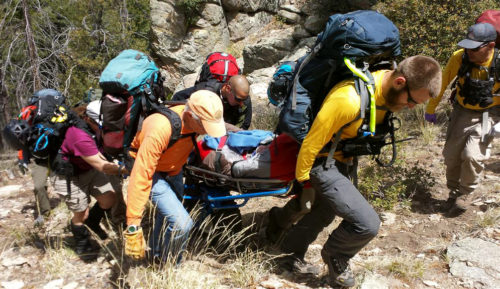By AMBER WHITE
Arizona Sonora News
It’s the start of the winter holiday season, and the snowbirds are on their way back to Arizona in their annual migration.
Their arrival changes the demographic scene and in some cases raises concerns for rescue agencies as more people not fully familiar with the wild desert and mountain terrain take to the outdoors in mild seasonal weather.

In the 2002-2003 winter season, an estimated 300,000 or more snowbirds were arriving in Arizona, according to a study by the Center for Business Research at Arizona State University.
That number appears to be increasing, but according to the Arizona Office of Tourism, no studies on snowbirds have been done in the past six years, said Kiva Couchon, the director of industry affairs at the office.
The annual winter migration of tourists includes people who come solely to escape the cold and those wanting to explore the rugged terrain by hiking, biking or participating in other outdoor activities. And the snow has already arrived in the Midwest and in a fury in parts of the Northeast, as the snowbirds come to the Sonoran desert.
The snowbird migration includes some people coming to Arizona with little understanding of its potentially extreme environment even in mils weather — people who may be more at risk of getting injured or dehydrated outdoors. But it can happen to anyone who isn’t fully prepared for the desert and desert mountains. There are no data on deaths in outdoor activities that happen in the winter months, but more people are outdoors during this time than during the scorching summer.
One of the most popular places for seasonal hiking is Sabino Canyon.
Abbey Harman, general manager at Sabino Canyon for 31 years, gives tours to people on the canyon shuttle. She said she sees a lot more people hiking in the winter months because it is cooler “We get a lot of snowbirds year after year,” Harman said. “It’s the same people so it’s like they’ve become part of the family. They come in and are so happy to see you.”
Sabino Canyon has hundreds of miles of hiking trails where access is toward the mountain range. It located in the Coronado National Forest. A Sabino Canyon tour allows visitors to explore the Blackett’s Ridge Trail, Telephone Line Trail and Hutch’s Pools.
One of the most popular things about Sabino Canyon is the hiking trails. People usually go in groups of two or three when hiking.
Five or six people died this year in the canyon because of heat exhaustion, dehydration and getting lost. Harman believes the majority of people who die are visiting from somewhere else, not necessary snowbirds, because they are not prepared to deal with the desert.
Cactuses and mesquite trees engulf the desert while their roots set in dry hard dirt. Jack rabbits and rattlesnakes roam the desert, coexisting with several other species that can survive months without rain and temperatures above 100 degrees.

Shelley Littin, public information officer at Pima County Search and Rescue Association, is a three-year employee and she said she loves it because of the outdoors, hiking, the mountains, athleticism and having the opportunity to help others to safely enjoy with the same activities.
“Personally, being a part of the Southern Arizona Rescue Association has allowed me to gain a lot of skills in terms of wilderness medicine and rescue that are very helpful for my own life when I’m out backpacking and doing things outdoors,” Littin said.
During her estimated 150 rescue missions, she went out to rescue hikers who strayed farther than they had anticipated or were slower than expected and overtaken by darkness. SARA volunteers also come across hikers with heat illness or exhaustion that need assistance.
How does a typical rescue or search work for SARA?
- Hiker calls 911
- Person tells operator it is a back country issue
- Sheriff’s department sends message to SARA volunteers phones or emails that says name of trailhead and some details about hiker in trouble
- Volunteers drive their own vehicles to the trailhead to meet-up
- Gear is assembled based on hiker’s needs
- Volunteers hike up trail to locate injured or lost hiker
“We are all volunteers, so we respond as we are able to,” Littin said. “If we have other applications, are at work, school, traveling or sick, then we don’t go. But if we are free and available, we go whenever we can.”
Before joining the organization, Littin got herself into a dangerous situation hiking in September in temperatures close to 100 degrees. She tried to hike up a familiar trail thinking it was only 12 miles, but it was really 18. The trail had overgrown vegetation and she ran out of water. Littin managed to find her way back to the trailhead despite being very dehydrated.
Lost Hikers:
- Get in a safe position
- Stay where you are at if you have food, water and appropriate clothing if you have someone looking for you
- Use cell phone if there is reception to call for help
- If there is nobody looking for a hiker or expecting them at a certain time, the hiker will have to do a self-rescue
- Sit in the shade
- Drink water
- Do not exhaust your body
- Try to be in an open area
- Make bright clothing as visible as possible
- Wait till dark to find trailhead if hot
Every search and rescue mission is different depending on severity. Of someone is lost, volunteers are sent on different trails to locate the person. An injured hiker is easier to locate and can usually be found with less people.
Snowbirds are not the only ones getting lost or injured while hiking. It’s a mixture of Arizona natives and those unfamiliar with environmental conditions. That’s why the “stupid hiker law” has been proposed.
Meanwhile, University of Arizona graduate Geoffrey Schultz recently launched a website, Trailvoyant, with app features that include maps for 1,600 miles of area trails, and information on where to find the nearest drinking water. It costs $5 a month to subscribe to the website.
Littin said the association receives more heat-related calls in the summer, but since winters here can be hotter than other places, people can get overheated any time of year in Arizona. On average, 100 rescues are done each year. This year has already gone over the average, by 15.
So-called “stupid hiker” laws have been proposed in Arizona, modeled after “stupid motorists” laws, Tucson has no active plans for such regulations. Such laws penalize hikers and other people in outdoors activities who do obviously stupid things to put themselves, and their rescuers, in danger. One issue: It’s difficult to differentiate what is stupid from what is an accident while hiking, according to Littin. It would be very challenging for the sheriff’s department to legally determine what happens on a trail, she said.
However, there are some national parks that have regulations covering careless behavior, or charge for back-country rescues. This is a problem because people become afraid of being charged and don’t call for help until it is too late and it makes it more dangerous for the rescuers to find them, some say.
“We would much rather go out and rescue somebody than go and recover a body,” Littin said.
##
Download high resolution images here.
 Amber White was born and raised in Tucson and spends most of her free time is spent indoors playing with her cats or watching reruns of her favorite TV shows. She wants to find a way to combine her passions for writing and animals after she graduates.
Amber White was born and raised in Tucson and spends most of her free time is spent indoors playing with her cats or watching reruns of her favorite TV shows. She wants to find a way to combine her passions for writing and animals after she graduates.

